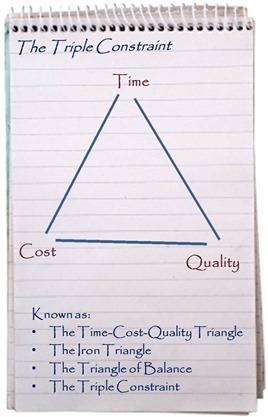Pocketblog has gone back to basics. This is part of an extended management course.
We are working through a series of blogs, looking at some of the essential models that a project manager will need. We have covered:
- The Project Lifecycle
- The Triple Constraint (here) – and in future blogs we will look at:
- Stakeholder Management
- The Critical Path
- The Gantt Chart
- Risk Management
Defining a Project
We define a project in terms of its purpose, goal, objectives and scope.
- Purpose: why we need it
- Goal: what it needs to achieve
- Objectives: the constraints we must meet
- Scope: The breadth and depth of the work to be done
Objectives come in Three Flavours
Objectives set constraints we must meet: time, cost and quality parameters that define our priorities. Once all of these are fixed, we can think of them as occupying three corners of a rigid triangle: the time-cost-quality triangle.
This is also known by other names, the most useful of which is the Triple Constraint. Because once you have a plan, any attempt to change one corner…
- to reduce the cost
- to speed up delivery
- to improve performance
… will only be possible if you are prepared to compromise one or both of the other two corners.
The important thing about the Triple Constraint is that it never tells you what to do – your primary and secondary time, cost or quality objectives must be your guides. But it will always show you clearly what your choices are.
An example…
You want your IT system to produce management data more quickly than it is specified to? Well that is okay. It can, as long as you are prepared to either:
- Compromise on budget, spending more on the system and on the people and systems that feed it with data – or
- Compromise on performance and accept either a reduced data set focused on the most important figures, or reduced data quality, giving first estimates only, based on the most material information, but awaiting the precision of the full information.
This is just an illustration, but it shows clearly how the Triple Constraint offers us options.

From the Management Pocketbooks series:


